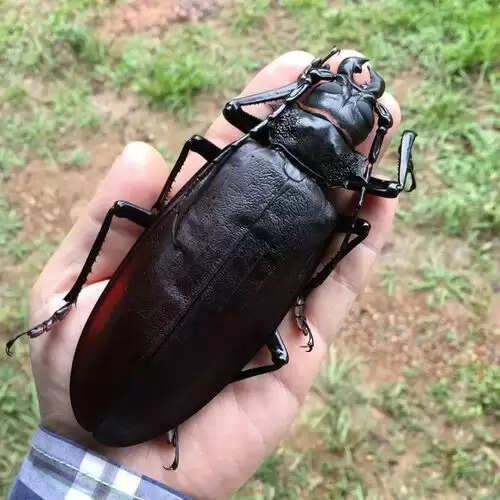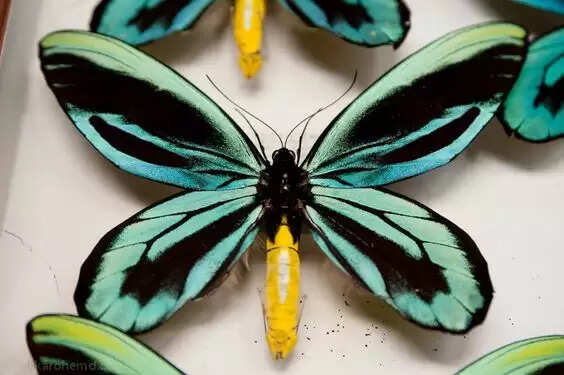Top 10 Largest Insects In The World

1/10 Titan Beetles: One of the biggest insects ever recorded, the titan beetle (Titanus giganteus) is a Neotropical longhorn beetle and the only species in the genus Titanus. One of the biggest beetles, with the largest credible specimen measuring 16.7 cm (6.6 in) in length. The larvae of titan beetles are thought to have a maximum size of 1 foot long and 2 inches broad. Pencils have been reported to break in half and human flesh to be sliced by the small, curved, and sharp mandibles. Titan beetles do not eat as adults and instead use pheromones to find mates while flying.

2/10 Stick Insects: The Phasmatodea is an order of insects whose members are often referred to as stick insects. It is also known as Phasmida, Phasmatoptera, or Spectra. Although many species have one of many secondary lines of defence in the form of startle displays, spines, or poisonous secretions, their inherent camouflage makes them difficult for predators to identify. All continents, with the exception of Antarctica, include members of the order, although the tropics and subtropics are where they are most common. Many of their species live quietly in the forest canopy and are herbivorous. The species Phryganistria chinensis, found in China in 2016, now holds the record for the world's longest bug, with one specimen reaching 25.2 inches, according to Guinness World Records.

3/10 Giant Wētās: Several species of wētā in the genus Deinacrida of the family Anostostomatidae are known as giant wētā. All except one of the indigenous giant wētā species in New Zealand are legally protected because extinction is thought to be a possibility. Without including the legs and antennae, these species may measure up to 10 cm (4 in), however their body masses are often no greater than 35 g (1.2 oz). Since imported animal pests nearly wiped them out on the mainland islands, they are mostly found on offshore islands in New Zealand. Its name derives from "wetapunga," a Maori phrase that means "god of ugly things."

4/10 Goliath Beetles: Any of the five species in the genus Goliathus are referred to as "Goliath beetles" after the historical giant Goliath. If size, mass, and weight are taken into consideration, goliath beetles are among the biggest insects on Earth. Many of Africa's tropical woods are home to goliath beetles, which largely eat fruit and tree sap. Goliath beetles are able to reach a weight of up to 80-100 grams in the larval stage, though adults are only about half that size.

5/10 Atlas Moths: The Atlas moth, or Attacus atlas, is a large Saturniid indigenous to Asian woods. One of the biggest lepidopterans is the Atlas moth, which has wings that may extend up to 24 cm (9.4 in) in length and have a surface area of 160 cm2. The Atlas moth does not feed after emerging from the cocoon; instead, it relies on fat storage for nourishment. It possesses a very short, vestigial proboscis. Adult Atlas moths fly poorly and clumsily. The moths sleep during the day and fly at night to save energy. They only have a short lifespan of a few days, during which time their primary goal is to find a mate. In South Asia, East Asia, and Africa, Southeast Asia including Borneo, dry tropical forests, secondary forests, and shrublands make up the majority of their habitat.

6/10 Tarantula Hawks: A spider wasp (Pompilidae) that feeds on tarantulas is known as a tarantula hawk. Members of genus Pepsis and Hemipepsis include tarantula hawks. One of the biggest parasitoid wasps, they paralyse their target with their sting before dragging it to a nest where they use it as living food. One egg is deposited on the prey, which hatches into a larva that consumes the host while it is still alive. Only the sting of a bullet ant causes more pain than a tarantula hawk species called Pepsis grossa. Other than Antarctica, they may be found on all continents. These wasps have blue-black bodies and vivid, rust-colored wings, and they may reach lengths of up to 6.5 cm, making them among the biggest wasps.

7/10 Mydas Flies:The Mydidae, often known as Mydas flies or Mydaidae flies, are a diversified family of flies. With 471 known species, it is a tiny family. The largest known fly, Gauromydas heros, is among them. Mydas flies may grow to a length of around 2.4 inches. Being primarily huge in size. In addition to being huge, several of the species mirror other stinging hymenopterans, particularly wasps. Although they may sometimes be found in other habitats, mydids are most commonly found in arid and semiarid parts of the world.

8/10 Hercules Beetles: A species of rhinoceros beetle called the Hercules beetle (Dynastes hercules) is found in the rainforests of southern Mexico, Central America, South America, and the Lesser Antilles. It is one of the biggest flying insects on the planet and the longest type of beetle that is still alive. Adult body sizes range from 50 and 85 mm in length and 29 and 42 mm in breadth (excluding the thoracic horn). Male beetles attack other males with their enormous horns while they are fighting over females. Male beetles may grow up to be nearly 7 inches long.

9/10 Giant Water Bugs: A family of freshwater hemipteran insects called Belostomatidae is sometimes referred to as toe-biters or huge water bugs. The Hemiptera order's biggest insects are these ones. Most species have a minimum length of 2 cm (0.8 in). The largest are those belonging to the genus Lethocerus, which may grow to a length of more than 12 cm (4.5 in)—almost as long as some of the biggest beetles in the world. Giant water bugs are renowned as ferocious predators in the streams and ponds where they inhabit. They can inject poisonous saliva into their victim and inflict a terrible bite with their enormous pincers. However, they are also consumed by people and prized throughout Asia's and southeast regions.

10/10 Queen Alexandra's Birdwings: The Queen Alexandra's birdwing, Ornithoptera alexandrae, is the biggest species of butterfly in the world, with females having wingspans that are just over 25 cm to 28 cm. Only the woodlands of the Oro Province in eastern Papua New Guinea are home to this birdwing. Due to its scarcity and distinction as the biggest butterfly in the world, the species is highly valued by butterfly collectors, and individual specimens may sell for several thousand dollars on the black market. Although habitat degradation is a greater danger to the survival of this species than poaching, the IUCN has listed the Queen Alexandra's birdwing as threatened due to the increased clearing of its habitat for oil palm, cocoa, and rubber plantations.


